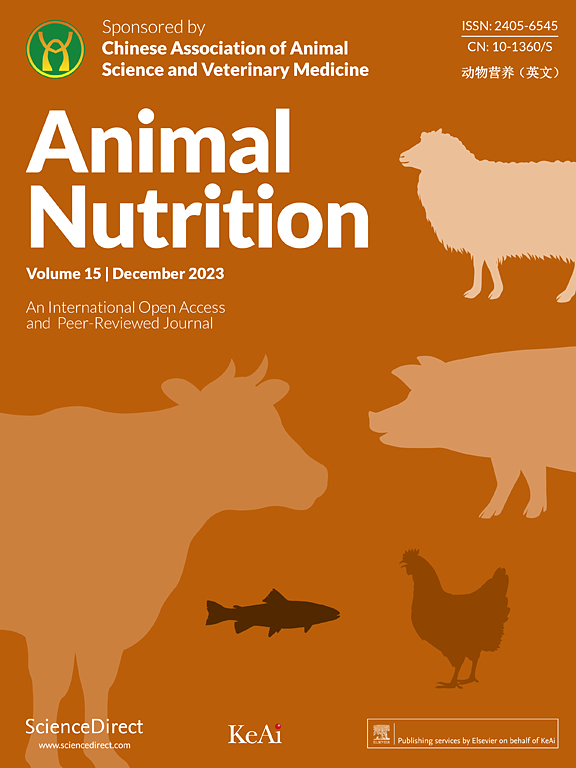葡萄籽提取物对奶牛瘤胃微生物源肌苷代谢紊乱的影响
IF 6.1
1区 农林科学
Q1 AGRICULTURE, DAIRY & ANIMAL SCIENCE
引用次数: 0
摘要
瘤胃微生物群及其代谢产物可以影响宿主的代谢反应。葡萄籽提取物(GSE)可以调节奶牛瘤胃微生物群和体外代谢产物,从而强调其对奶牛能量代谢的潜在益处。本研究将中国荷斯坦奶牛随机分为2组(每组10头),分别在产犊后-3 ~ 3周在饲粮中添加或不添加GSE(每头15 g/d)。结果表明:饲粮中添加GSE可提高脂肪校正乳产量(P = 0.003)、饲料效率(P = 0.045)、降低乳体细胞计数(P = 0.031)。此外,GSE还能提高血清总葡萄糖(P = 0.011)和降低非酯化脂肪酸(P <;0.001)、β-羟基丁酸(P = 0.002)、触珠蛋白(P = 0.003)和血清淀粉样蛋白A (P = 0.008)浓度以及较低的丙氨酸/天冬氨酸转氨酶活性(P <;0.05)。与对照组相比,添加GSE改变了瘤胃微生物群的组成和代谢谱(P <;0.05),血清中微生物来源的肌苷含量更高(P <;0.001)和瘤胃液(P <;0.001)。此外,瘤胃肌苷与产奶量和缓解负能量平衡呈正相关(r >;0.5, P <;0.05)。此外,正如GSE在体内的作用一样,外源性肌苷处理对体外(1 μM,肝细胞和脂肪细胞)和酮症奶牛(8 mg/kg / d, n = 5)的能量代谢和炎症产生了相似的影响(P <;0.05)。总之,这些结果强调了产犊后瘤胃微生物来源的肌苷在维持代谢稳态方面的有益作用。由此可见,饲粮中添加GSE可能通过提高瘤胃肌苷产量来改善奶牛的能量代谢和炎症状态。在过渡期内,饲喂GSE和肌苷可能是缓解奶牛健康问题和优化生产力的一种潜在策略。本文章由计算机程序翻译,如有差异,请以英文原文为准。
Ruminal microbiota-derived inosine alleviates metabolic disorders in dairy cows supplemented with grape seed extract
Ruminal microbiota and their metabolites can shape host metabolic responses. Grape seed extract (GSE) can modulate ruminal microbiota profiles and metabolites in vitro, thus, underscoring their potential benefits on energy metabolism in dairy cows. In this study, Chinese Holstein cows were randomly divided into two groups (n = 10 per group) with or without dietary supplementation of GSE (15 g/d per cow) from -3 to 3 wk relative to calving. The results showed that GSE supplementation led to increased fat corrected milk yield (P = 0.003), feed efficiency (P = 0.045) and reduced milk somatic cell count (P = 0.031). In addition, GSE resulted in greater overall serum glucose (P = 0.011) and lower non-esterified fatty acids (P < 0.001), β-hydroxybutyric acid (P = 0.002), haptoglobin (P = 0.003), and serum amyloid A (P = 0.008) concentrations along with lower alanine/aspartate aminotransferase activity (P < 0.05). Compared with the control group, GSE supplementation altered the composition and metabolic profiles of ruminal microbiota (P < 0.05), with microbiota-derived inosine being greater both in serum (P < 0.001) and rumen fluid (P < 0.001). In addition, ruminal inosine correlated positively with milk production and alleviation of negative energy balance (r > 0.5, P < 0.05). Furthermore, just as GSE in vivo, exogenous inosine treatment elicited similar effects on energy metabolism and inflammation both in vitro (1 μM, hepatocytes and adipocytes) and in dairy cows with ketosis (8 mg/kg per day, n = 5) (P < 0.05). Overall, results underscore a beneficial effect of ruminal microbiota-derived inosine in maintaining metabolic homeostasis postcalving. Thus, dietary GSE supplementation may improve energy metabolism and inflammatory state in dairy cows by enhancing ruminal-derived inosine production. Feeding GSE and inosine can be a potential strategy to alleviate health problems and optimize productivity in dairy cows during the transition period.
求助全文
通过发布文献求助,成功后即可免费获取论文全文。
去求助
来源期刊

Animal Nutrition
Agricultural and Biological Sciences-Animal Science and Zoology
CiteScore
7.40
自引率
3.20%
发文量
172
审稿时长
12 weeks
期刊介绍:
Animal Nutrition encompasses the full gamut of animal nutritional sciences and reviews including, but not limited to, fundamental aspects of animal nutrition such as nutritional requirements, metabolic studies, body composition, energetics, immunology, neuroscience, microbiology, genetics and molecular and cell biology related to nutrition, and more applied aspects of animal nutrition, such as raw material evaluation, feed additives, nutritive value of novel ingredients and feed safety.
 求助内容:
求助内容: 应助结果提醒方式:
应助结果提醒方式:


